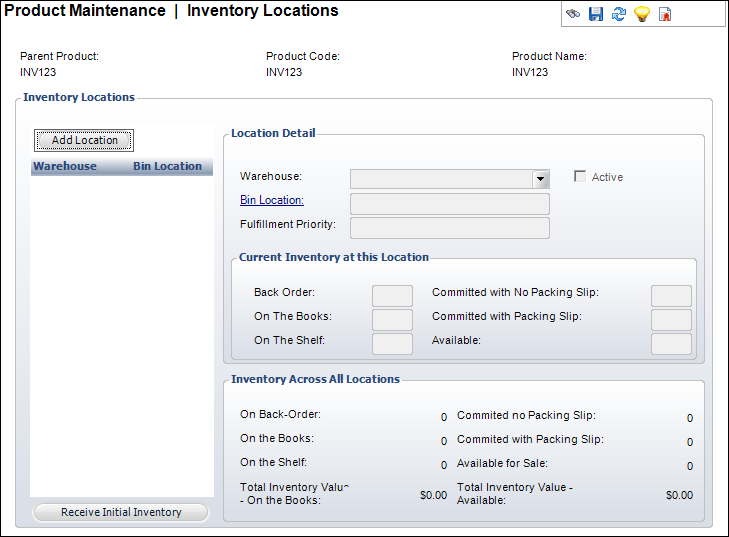 This
task is only available if “Individual Product” is selected as the Product
Type on the General Product Setup screen.
This
task is only available if “Individual Product” is selected as the Product
Type on the General Product Setup screen.
 This
task is only available if “Individual Product” is selected as the Product
Type on the General Product Setup screen.
This
task is only available if “Individual Product” is selected as the Product
Type on the General Product Setup screen.
The Inventory Locations screen allows you to enter information on locations of warehouses and bins where inventory is received. Inventory locations can be used for both “inventoried” and “non-inventoried” products. Non-inventoried products will use an inventory location if packing slips are required to deliver the product.
To specify inventory information:
1. From
the Subsystem Specific task category, click Inventory
Information.
The Inventory Locations screen displays, as shown below.

2. Click Add Location.
3. Select the Warehouse from the drop-down list.
4. By default, new locations are active. If the location is inactive, uncheck the Active checkbox.
5. Click the Bin Location to search for and select the appropriate bin located in the selected warehouse.
6. Enter a Fulfillment Priority.
![]() The
Fulfillment Priority will default to the next number in the sequence.
For example, if one location already exists, the Fulfillment Priority
will default to ‘2’. This field can be edited. If the location requires
a higher priority, enter the Fulfillment Priority number and the other
locations will update accordingly.
The
Fulfillment Priority will default to the next number in the sequence.
For example, if one location already exists, the Fulfillment Priority
will default to ‘2’. This field can be edited. If the location requires
a higher priority, enter the Fulfillment Priority number and the other
locations will update accordingly.
7. If this is a new inventory product, click
Receive Initial
Inventory.
The Inventory Receipt screen displays.
 The
fields in the Current Inventory at this Location section are only enabled
if the “Direct Inventory Update” checkbox is selected on the Inventory
Parameters screen during the organization unit setup. These fields should
only be enabled and edited in an emergency situation.
The
fields in the Current Inventory at this Location section are only enabled
if the “Direct Inventory Update” checkbox is selected on the Inventory
Parameters screen during the organization unit setup. These fields should
only be enabled and edited in an emergency situation.
8. Click Save.
Screen Element |
Description |
|---|---|
Inventory Locations |
|
Add Location |
Button. This adds a new entry to the Inventory locations table. |
Receive Initial Inventory |
Button. When clicked, the initial inventory information is received for the location based on the cost recorded in the system for inventory. This button is only displayed when adding the first location to a new product. |
Location Detail |
|
Warehouse |
Drop-down. The warehouse where the inventory is stored. Only active warehouses will be available in this drop-down.
The options in this drop-down are defined on the Warehouse Definition screen. For more information, please see Defining Warehouses. |
Bin Location |
Link. The name associated with a storage bin in the selected warehouse. |
Fulfillment Priority |
Text box. When this product is ordered, it is retrieved from the warehouse based on the priority number set here. If this warehouse has a priority of “1,” then the inventory is retrieved from this warehouse first. If the inventory is not available at this warehouse, then the system will move to the warehouse with the next numeric priority, and so on.
This value increments by 1 from the last warehouse value. Two warehouses of a product cannot have the same fulfillment priority number. |
Active |
Checkbox. When checked, indicates the warehouse location is active. When unchecked, users are warned on the Inventory Receipt and Transfer screen that this is not an active location. |
Current Inventory at this Location |
|
Back Order |
Text box. Displays the quantity of the product that is on back order at this warehouse. |
On The Books |
Text box. Displays the quantity of the product (unsold unit) that is on the books. This is inventory as represented in the General Ledger. This number multiplied by the unit cost should equal the GL inventory number. This number decreases only after invoicing, when cost of goods sold (COGS) transactions are created that relieve inventory. The On The Book or On The Shelf quantity, as opposed to the available quantity, is used for calculation when returning an inventoried product. |
On The Shelf |
Text box. Displays the sum of the Committed with No Packing Slip, Committed with Packing Slip, and Available totals. |
Committed with No Packing Slip |
Text box. The number of units for which there are current orders but no packing slips have been generated. They are counted as on the shelf but not available for future orders. |
Committed with Packing Slip |
Text box. The number of units for which there are current orders and packing slips have been generated, but the products are not yet shipped. They are counted as on the shelf but not available for future orders. |
Available |
Text box. The number of units that are available for inclusion in future orders. This total is the On the Shelf minus the Committed with No Packing Slip and Committed with Packing Slip.
If no units are available, the product is placed on back order. |